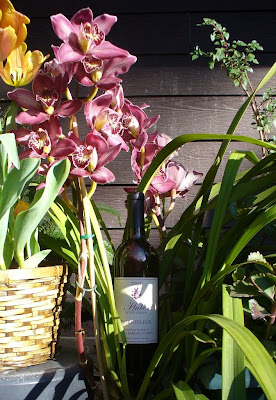 Italy is a country whose wines I'd like to visit more often. No other nation seems to have quite as immense an array of growing regions and varietals as Italy. There are the big names like Amarone, Barolo, Barbaresco and Brunello if you are looking for a way to drop $50+ on a bottle of wine. Being the value conscious buyer that I am, I've been looking into the dozens if not hundreds of varietals and regions (Italy has an utterly confusing appellation system based on IGT, DOC and DOCG designations) that aren't as well recognized as the most noble wines of Italy. There's a general perception that Italian wines aren't good values, but that depends on your perception of value. If you're looking for a unique wine that synergizes with food, the lesser-know appellations of Italy have much to offer. A good recent white wine find was the Suavia 2007 Soave Classico, a blend of 95% Garganega and 5% Trebbiano di Soave that's well balanced and slightly reminiscent of green apples. Pictured here are the Caterina Zardini 2005 Valpolicella Classico Superiore and the Luciano Landi 2006 Gavigliano Lacrima di Morro d'Alba. Both are moderately priced and show loads of character.
Italy is a country whose wines I'd like to visit more often. No other nation seems to have quite as immense an array of growing regions and varietals as Italy. There are the big names like Amarone, Barolo, Barbaresco and Brunello if you are looking for a way to drop $50+ on a bottle of wine. Being the value conscious buyer that I am, I've been looking into the dozens if not hundreds of varietals and regions (Italy has an utterly confusing appellation system based on IGT, DOC and DOCG designations) that aren't as well recognized as the most noble wines of Italy. There's a general perception that Italian wines aren't good values, but that depends on your perception of value. If you're looking for a unique wine that synergizes with food, the lesser-know appellations of Italy have much to offer. A good recent white wine find was the Suavia 2007 Soave Classico, a blend of 95% Garganega and 5% Trebbiano di Soave that's well balanced and slightly reminiscent of green apples. Pictured here are the Caterina Zardini 2005 Valpolicella Classico Superiore and the Luciano Landi 2006 Gavigliano Lacrima di Morro d'Alba. Both are moderately priced and show loads of character.The Zardini 2005 Valpolicella is a blockbuster styled wine made from 60% Corvina and Corvina Veronese and 40% Rondinella, but a blockbuster that's unique enough to keep it from slipping into an abyss of anonymity. I couldn't help but imagine this wine as anything other than a Clint Eastwood spaghetti Western. Certainly it's a full bodied masculine wine with a smooth round entry, sweet mid-palate and polished, yet tannic finish. I would be surprised if this wine didn't see significant barrel aging; however, the oak is tastefully integrated to provide a crowd-pleasing New World-styled palate. However, the bouquet is a stark departure from the sweetly fruited palate. The Man with No Name was always chomping on a cigar while he glared out over miles of parched brush. Convert that image to a smell and that's the bouquet of this wine. Dusty, dry, vegetative and reminiscent of burnt tobacco (or slightly more pejoratively, an ash tray). One can smell that sweet berry jam a bit, too, but fortunately the scowling bounty hunter aromas win out.
One should expect a Valpolicella to be fairly rich and unctuous. Valpolicella is typically produced like a less-intense Amarone. Amarones are made by drying out grapes on mats to essentially raisin the grapes, which produces a concentrated and powerful wine. While the sweetness of this wine was eventually a little overbearing and it's only built to pair with very rich foods, one must appreciate that it captures an intriguing combination of traditional expression, New World polish, and fascinating (if potentially off-putting) aromatics.
The Landi 2006 Lacrima is a very feminine wine in comparison. Lacrima di Morro is an ancient varietal that is known for its hauntingly floral bouquet. Or at least that's the description that motivated me to order this wine. It didn't disappoint. The bottle lists rosa canina and marasca as the floral aromas it evokes; I have no idea what these blossoms smell like, but the floral 'theme' is right on the mark. The wine smells almost like a fragrance with slightly pungent floral aromas, more fragrant rosy aromas, and a musky slightly spicy cinnamon-like smell as well. I'm tempted to say this is 4 parts perfume, 1 part cologne on the nose. Divide it as you'd like, this is a red wine that compares to even the most flamboyant of white wines in terms of its floral expression, though they are not high-toned like the honeysuckle or jasmin typical of aromatic white wines.
The palate screams 'food wine' with its combination of acidity, linear flavors and minimal oak influence. Light tannins complement flavors primarily of sour cherry. It certainly became more complete on its own over time, but the food-wine combination was greater than the sum of its parts. Whereas the Valpolicella became flabby and ungainly, the Lacrima picked up more weight and enhanced the food as well. Was one of these two wines better than the other? Well, I liked the Lacrima slightly better because I consider floral aromas a rare and highly desirable trait in any wine. A professional reviewer would almost certainly rate the Valpolicella significantly higher based on the strength of its full-bodied palate. But both performed admirably in the appropriate context and absolutely 'oozed character' as I like to say.
Caterina Zardini 2005 Valpolicella Classico Superiore
Score: 87-90
Price: $20 from Winelibrary
Luciano Landi 2006 Gavigliano Lacrima di Morro d'Alba
Score: 89-92
Price: $17 from Wine Exchange


